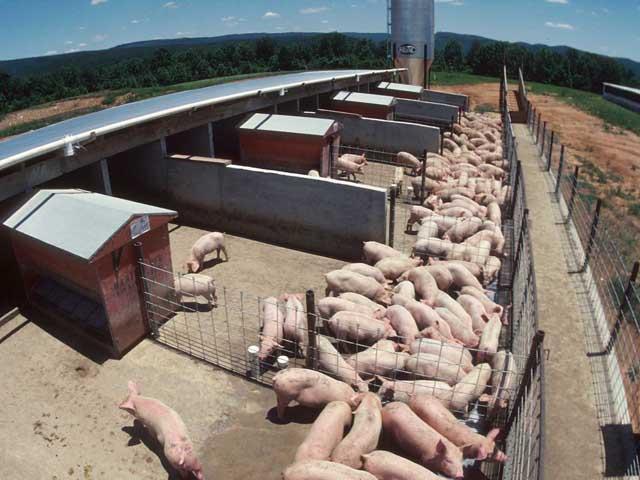Hog Industry Faces Financial Disaster
Industry Officials Press for Relief Package for Hog Producers Amid Pandemic
OMAHA (DTN) -- Hog producers currently are holding on to about 1.1 million animals that should have been slaughtered already. The number could grow to about 1.6 million by the end of August and up to 2.5 million by the end of the year.
Those numbers should hold, assuming hog-processing plants can keep operations churning at 95% capacity for the rest of the year.
The 5% loss in capacity is making life hard on thousands of producers, many who may be staring bankruptcy in the face.
The industry already has euthanized hundreds of thousands of hogs when the COVID-19 economic shutdown essentially shutdown slaughter plants back in spring.
Though the industry has made a comeback as more hogs are flowing into retail outlets, the food-service industry hasn't bounced back as quickly from the shutdown.
"This is a very serious situation," Steve Meyer, a hog industry economist at Kerns and Associates, said during a National Pork Producers Council press conference on Monday.
"It is a kind of slow-motion disaster. The value of pigs has taken a dramatic hit since February. Capacity has comeback dramatically since May. But we are still at 5% below normal capacity and I don't know if we will ever get that back."
He said social-distancing measures taken to protect employees at hog plants has made it difficult if not impossible to return those plants to 100% capacity.
From March 1 to July 10, he said, the value of pork has lost about $4.7 billion.
"They have had to euthanize a lot of animals," Meyer said.
P[L1] D[0x0] M[300x250] OOP[F] ADUNIT[] T[]
"Things look better but they're not. Producers will either have to hold pigs or will have to destroy some pigs. This is by far the largest economic hit this industry has taken."
Meyer said although he has not heard much talk about bankruptcy so far, he knows they're coming.
Howard "A.V." Roth, NPPC president and Wauzeka, Wisconsin, hog farmer, said hog farmers don't have time to wait for assistance.
"We need help now to weather this unprecedented crisis," he said.
"Without this, me and thousands of hog farmers could go out of business. This has created a financial disaster nationwide. We need Congress to come together quickly. The consequences of inaction are too great."
Pork producers have received about $394.3 million under the Coronavirus Food Assistance Program (CFAP) at USDA, as of Monday. That accounts for only about 6.3% of the $6.2 billion in aid to farmers and livestock producers that USDA has provided so far under the program.
Rachel Gantz, a spokesperson for NPPC, stated to DTN that the group appreciated CFAP provides more aid to pork producers than in USDA's trade-retaliation relief, "but it still falls short of what's needed to sustain thousands of impacted producers." Gantz reiterated pork producer are set to lose more than $5 billion this year.
The U.S. Senate is returning to Washington after a recess and the industry is pushing for immediate help.
Earlier this month the RELIEF for Producers Act of 2020, was introduced in the Senate by Jim Inhofe, R-Oklahoma; Richard Burr, R-North Carolina; Joni Ernst, R-Iowa; Chuck Grassley, R-Iowa; and Thom Tillis, R-North Carolina.
The legislation would provide compensation to farmers who are forced to euthanize or donate livestock that cannot be processed.
In the U.S. House of Representatives, Agriculture Committee Chairman Rep. Collin Peterson, D-Minnesota, supports the legislation.
Nick Giordano, vice president and counsel in global government affairs for NPPC, said the industry is pushing for direct payments to be part of a future relief package.
"Our specific (goal), as in legislation, is open-ended," he said.
"We really don't know what the final damage is going to be. We've just been trying to keep as many producers as possible in business. We're going to lose producers small and large. The question is, how many."
The goal, he said, is to have a final bill ready for the president's signature by sometime in August.
"Our producers are hurting," Giordano said. "Our folks really do need a lifeline and they need it quickly."
On average, hog producers entered 2020 expecting to make about $20 a head profit. Now, Meyer said hog farmers are expecting an average loss of $10 per head for the whole year.
"There's only so much cash out there," Meyer said.
"Lenders say there are some farmers in financial difficulty at this point. It won't be just small producers, but there will be some larger producers who will have some difficulty as well."
Farmers also have seen losses from the costs of euthanasia, disposal and donation of pigs.
Todd Neeley can be reached at todd.neeley@dtn.com
Follow him on Twitter @toddneeleyDTN
(c) Copyright 2020 DTN, LLC. All rights reserved.






